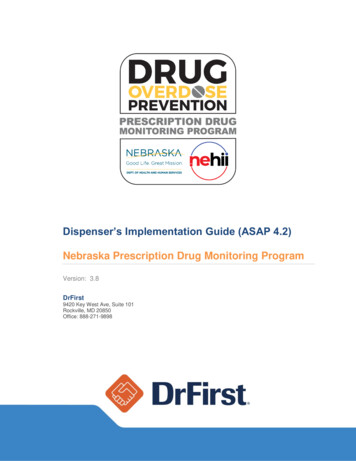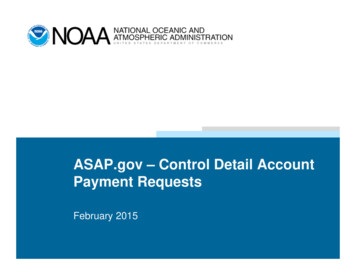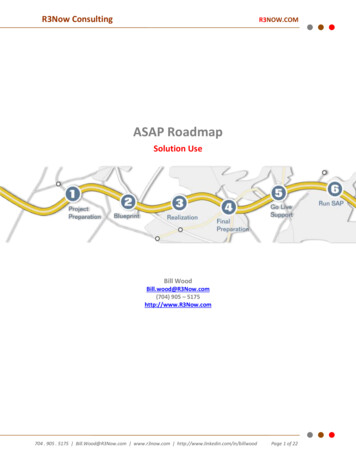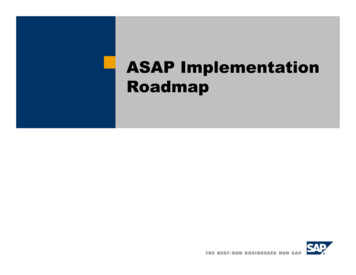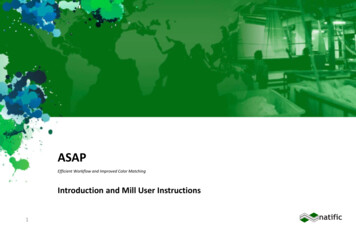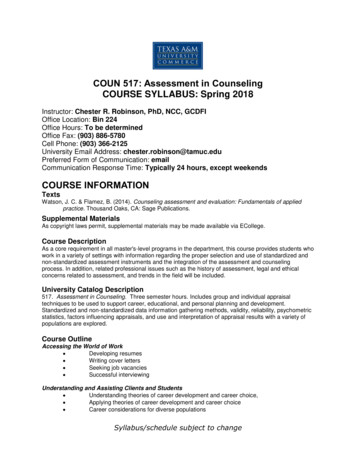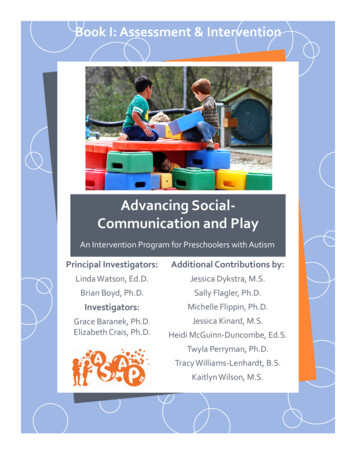
Transcription
Book I: Assessment & InterventionAdvancing SocialCommunication and PlayAn Intervention Program for Preschoolers with AutismPrincipal Investigators:Additional Contributions by:Linda Watson, Ed.D.Jessica Dykstra, M.S.Brian Boyd, Ph.D.Sally Flagler, Ph.D.Investigators:Michelle Flippin, Ph.D.Grace Baranek, Ph.D.Elizabeth Crais, Ph.D.Jessica Kinard, M.S.Heidi McGuinn-Duncombe, Ed.S.Twyla Perryman, Ph.D.Tracy Williams-Lenhardt, B.S.Kaitlyn Wilson, M.S.
AdvancingSocial-Communication & Play:An Intervention Program for Preschoolers with AutismBOOK I:ASSESSMENT AND INTERVENTIONIntroductionAssessmentsPicture DictionaryInterventionTips & TroubleshootingResearchPrincipal Investigators:Linda Watson, Ed.D.Brian Boyd, Ph.D.Investigators:Grace Baranek, Ph.D.Elizabeth Crais, Ph.D.Additional Contributions By:Jessica Dykstra, M.S.Sally Flagler, Ph.D.Michelle Flippin, Ph.D.Jessica Kinard, M.S.Heidi McGuinn Duncombe, Ed.S.Twyla Perryman, Ph.D.Tracy Williams Lenhardt, B.S.Kaitlyn Wilson, M.S.ASAP ProjectUniversity of North Carolina at Chapel HillCampus Box #7122 Chapel Hill, NC 27599ASAP@unc.edu 2011 University of North Carolina at Chapel Hill. All rights reserved.
N 1: IntroductionWhat is ASAP?What is Joint Attention?What is Symbolic Play?Why is the ASAP Intervention Important for Preschoolers with Autism?Who are the Key Players in Implementing the ASAP Program?Additional Information for the TeacherAdditional Information for the Teaching AssistantAdditional Information for the TherapistASAP and the Standard Course of StudyHandouts for Other Key Players in the ASAP ProgramFor the ParentFor the Administrator22345577911111315SECTION 2: Assessment InstructionsAssessment of Social-Communication to Identify Intervention TargetsSocial-Communication Skill Levels1619Assessment of Play to Identify Intervention TargetsPlay Skill Levels2022Assessment Method OptionsDetermining Goals and Objectives for Intervention: ―Where Do I Start?‖Case Studies: Determining Goals and Objectives242526SECTION 3: Unstructured AssessmentsUnstructured Assessment of Social-CommunicationUnstructured ―Experience-Based‖ Assessment of Social-CommunicationSummary Score SheetDevelopmental Profile of Social-Communication SkillsiASAP Manual27282932
Unstructured Assessment of PlayUnstructured ―Experience-Based‖ Assessment of Play Summary Score SheetDevelopmental Profile of Play Skills33343738SECTION 4: Structured AssessmentsStructured Assessment of Social-CommunicationPart I: One-to-One with an AdultGeneral ProceduresAssessment Scenarios39394040Part II: Classroom Social-Communication Observation (Small Group)General Procedures4444Scoring the Structured Assessment of Social-CommunicationStructured Assessment of Social-Communication WorksheetsStructured Assessment of Social-Communication Summary Score SheetDevelopmental Profile of Social-Communication Skills45465357Structured Assessment of PlayPart I: One-to-One with an AdultGeneral Procedures585858Part II: Classroom Play Observation (Small Group)General Procedures5959Scoring the Structured Assessment of PlayStructured Assessment of Play WorksheetsStructured Assessment of Play Summary Score SheetDevelopmental Profile of Play Skills6061656869SECTION 5: Picture DictionarySocial-Communication LevelsSocial InteractionRequestingJoint Attention70707274Play 98082SECTION 6: Sample Assessments & InterventionSample Social-Communication AssessmentStructured Assessment of Social-Communication WorksheetsStructured Assessment of Social-Communication Summary Score SheetDevelopmental Profile of Social-Communication SkillsiiASAP Manual8586869397
Sample Play AssessmentStructured Assessment of Play WorksheetsStructured Assessment of Play Summary Score SheetDevelopmental Profile of Play Skills9898102105Sample Form Completion for Intervention PlanningPreference Assessment FormClassroom Activity MatrixPlanning Goal SheetCompleted Goal Sheet106106107108109110SECTION 7: InterventionThe Importance of Effective Teaming111The ASAP InterventionGeneral Guidelines for Conducting One-to-One Teaching SessionsGeneral Guidelines for Conducting Group Teaching SessionsWhat is SEW?Weaving SEW into Classroom Activities and RoutinesSurveying the Classroom LandscapePurposefully Planning Teaching SessionsDistributed Learning TrialsWhen to Move On to the Next Skill112112113114118118119120121General Teaching StrategiesHow Do You Teach Complex Skills?Other Teaching StrategiesPrompting and FadingReinforcementVisual Supports121121123124125126128SECTION 8: Tips & TroubleshootingTips and Troubleshooting with Individual ChildrenProgress and MasteryChild Characteristics and BehaviorsDifficulty with Specific SkillsTips for Generalizing Skills129129130132133Tips and Troubleshooting in the ClassroomClassroom CharacteristicsIncorporating Peers in the InterventionTips for Group Management134134135135iiiASAP Manual
137SECTION 9: ResearchResearch Foundations for the ASAP Program138BackgroundTypical Development of Joint AttentionTypical Development of Symbolic PlayHow are Joint Attention and Symbolic Play Linked Together?138138138139What is the ASAP Intervention Model?Research on the Importance of Including Social-Communication in ASAPResearch on the Importance of Including Play in ASAPResearch on the Importance of Using One-to-One Instruction in ASAPResearch on the Importance of Including Classroom Instruction in ASAPResearch on Intervention Strategies for Children with Autism140140142142143143References144ivASAP Manual
tablesI.1I.2I.3I.4I.5I.6Sample North Carolina Early Learning Expectations Addressed by ASAPSkill Levels Across Three Categories of Social-CommunicationSkills Levels Across Four Categories of PlayDirections for Determining Goals and ObjectivesExamples of Embedding SEW into Transition and Snack TimesPrompt HierarchyvASAP Manual10192225120125
figuresI.1I.2I.3I.4I.5ASAP Model of Communication DevelopmentASAP Model for Play DevelopmentPictorial Overview of SEWExample of a Child‘s Within Activity ScheduleASAP Intervention ModelviASAP Manual1721117127141
acknowledgementsTHANK YOUto the many people who participated and contributedto make this project possibleFocusGroupParticipantsFrank Porter GrahamChild DevelopmentInstituteWake County PublicSchoolsJohn CotterKathy DavisMary JenneDon TrullPreschool teachersChildren & familiesPreschool teachers,teaching assistants, &therapistsChildren & familiesUniversity of NorthCarolina at Chapel HillKathleen BerrySpeech-language pathologygraduate studentsGraduate student assessorsTherapist &Teacher ManualReviewersThe research reported here was supported by the Institute of Education Sciences, U.S. Department ofEducation, through Grant R324B070056 to UNC-Chapel Hill. The opinions expressed are those of theauthors and do not represent views of the Institute or the U.S. Department of Education.viiASAP Manual
1INTRODUCTIONPageWhat is ASAP?What is Joint Attention?What is Symbolic Play?Why is the ASAP Intervention Important for Preschoolers with Autism?2234Who are the Key Players in Implementing the ASAP Program?Additional Information for the TeacherAdditional Information for the Teaching AssistantAdditional Information for the Therapist5577ASAP and the Standard Course of StudyTable I.1: Sample North Carolina Early Learning Expectations Addressed by ASAP910Handouts for Other Key Players in the ASAP ProgramFor the ParentFor the Administrator1111131ASAP Manual - Introduction
What is ASAP?ASAP stands for ―Advancing Social-Communication And Play: An Intervention Program forPreschoolers with Autism.‖ This is an intervention program to help teachers, therapists, and others fosterthe development of important communication and play skills in young children with autism. Specifically,the end goal of the social-communication portion of this program is for preschoolers with autism to developjoint attention skills, and the end goal of the play portion of this program is for preschoolers with autism todevelop symbolic play skills. ASAP is intended to supplement other more comprehensive interventionprograms for young children with autism (that is, programs addressing a broad range of goals in the areasof language, cognition, social interaction, self-help skills, behavior regulation and so forth). Recentresearch supports the importance of specific efforts to improve joint attention and symbolic play skills inpreschoolers with autism if we are to help these children achieve their full potential as they get older. (Wehave provided references for some of the key studies and a summary of their findings in Book I – Section 9:Research.) Our goal in ASAP is to provide objectives, materials and strategies that can be blendedsuccessfully with a variety of different curricula used in public school preschool program s that servechildren with autism.What is Joint Attention?When one person purposefully coordinates his or her focus ofattention with that of another person, we refer to the behavioras “joint attention.” Joint attention involves two peoplepaying attention to the same thing. But it is more than justpaying attention, because in joint attention two people payattention to the same thing intentionally and for socialreasons. Thus, if an adult gives a child an attractive toy, andthe child looks at or plays with the toy, we can say the child ispaying attention to the toy. But we cannot be sure whether thechild is simply paying attention to the interesting properties of the toy, or whether he is aware that the adultis sharing his attention to the toy. However, if the child looks at the toy and up to the adult who gave it tohim and then back to the toy, then we can say the child is engaging in joint attention. That is, by lookingfrom the toy to the adult and back to the toy, the child has shown that he is aware of the toy and is awarethat the adult is also looking at the toy. Both the child and adult are purposefully sharing the same focus ofattention.There are two general types of joint attention behaviors. The first type involves behaviors for i nitiating bidsfor joint attention. We initiate bids for joint attention by drawing the attention of others to something wewant them to notice. Here are some examples of common ways young children initiate bids for jointattention: Pointing: a young boy sees an airplane in the sky, and points up to it so that his father will look upat the plane as well. Showing: a toddler finds an insect in the grass, picks it up, and shows it to her mother. Giving: a child picks up a colorful fall leaf and gives it to his brother (often young children willwant the interesting object back immediately!). Alternating gaze: a young girl sees an unfamiliar cat in the yard, inhales sharply while looking ather mother, and then looks back at the cat. Combining strategies: a child points to pictures in a book he is sharing with his father, and says,―da?‖ each time he points, thus combining a gesture with a vocalization; or he sees a bubble floatingdown, says, ―bubu‖ and looks at his sister and back at the bubble, combining alternating gaze with aword.2ASAP Manual - Introduction
In each of these examples, the child is initiating a bid for joint attention. Even if the child is not yet talking,his or her nonverbal behaviors communicate ideas such as, ―Look at that!‖ or ―Do you see that?‖ or ―Wow,isn‘t that interesting?‖ The child is not just paying attention to an object or event, but also wants to be suresomeone else is paying attention to the same object or event and therefore sharing in the experience.The second type of joint attention behavior is responding to bids for joint attention. In this situation, theother interaction partner has initiated a bid for joint attention, as described above, and the responder showsthat s/he is shifting his or her attention to the object or event that the partner is pointing to, showing, etc.Below are some examples of how young children may respond to bids for joint attention: Following a point: a father points to an elephant at the zoo, and the child shifts the direction of hisgaze in order to look in the direction that her father is pointing. Responding to showing: a mother shows her toddler a fluffy stuffed toy, and the child looks at hismother, smiles, and looks back at the toy. Responding to a gaze shift: an older sister is playing in the sandbox with her young brother. Shenotices a squirrel that is near the sandbox, looks at her brother and then at the squirrel. The youngerbrother looks at his sister and then looks in the same direction his sister is looking.Thus, when a child responds to a bid for joint attention, s/he looks in order to see what someone else ispaying attention to, so they can share that interest.By the time typically developing children are 12 months old they are initiating and responding to jointattention bids. These behaviors do not just happen in infancy, however. All people engage in joint attentionas they communicate with other people throughout their lives. Joint attention behaviors are especiallyimportant for young children‘s language learning. Young children who are better able to follow theattention of other people by responding to joint attention bids have more chances to connect word s toobjects. For example, if a parent says, ―Look at that bird‖ while pointing toward the birdfeeder, and thechild looks in the direction the parent is looking or pointing, then the child has an opportunity to associatethe word ―bird‖ with the animal on the birdfeeder. But if the child continues to look at the toy truck he isholding in his hand, then he misses a chance to learn that the word ―bird‖ stands for a feathered creaturethat eats seeds.Initiating joint attention bids also provides children with more opportunities for social interaction andlanguage learning. When young children initiate joint attention, they are very likely to get a positiveresponse in return. So a child who initiates more joint attention will lead other people to engage in socialinteractions with him or her around objects that are of interest to the child. Joint attention bids from thechild also usually lead the communication partner to talk in ways that promote the child‘s languagelearning. If a child extends an object toward an adult and looks at the adult, then it is very likely the adultwill talk to the child, saying things such as, ―What did you find? Oh, that‘s a bug!‖ So the more a childinitiates, the more s/he is likely to hear people talk about the things that have grabbed the child‘s interest ata particular point in time. This is an ideal situation for children to learn language.What is Symbolic Play?Symbolic play is play that involves pretending. When children pretendthat one object, such as a banana, is another object, such as a telephone,they clearly show that they have reached a level of symbolic play.Symbolic play is also seen when children pretend they are using anobject that is not really present, such as pretending to put food on aplate. Yet another type of symbolic play is seen when children engage inrole play, such as pretending to be a parent or a teacher or a firefighter.3ASAP Manual - Introduction
Play with objects develops in a predictable sequence in most children, as outlined below: When infants first begin to handle objects, they explore all objects in similar ways, such as bymouthing, poking, and banging them, no matter what type of object it is. Next, infants begin to do different actions with different types of objects, such as squeezing softobjects, banging hard ones, and rolling round ones. As they continue experimenting and learning about objects, children begin to use two or moreobjects in combination with each other, such as by taking objects apart or putting objects intocontainers. Children then use objects in the expected ways, but with the beginnings of ―pretending.‖ Forexample, a child may pick up an empty cup and pretend to drink from it, use a spoon to stir in anempty bowl, or push a toy truck while making motor sounds. A later step is to use objects with other people or dolls. At this point, the child might ―feed‖ a dollor stuffed animal, or insert a driver into a toy truck. Still later, the child will use one object to stand for another one, such as by putting a bowl on hishead and pretending that he is wearing a hat. As the child‘s ability to pretend grows, s/he takes on the roles of other people who are familiar tohim or her, such as pretending to play house or work in the yard. Still later, the child will take on fantasy roles, such as pretending to be a superhero, and willparticipate in assigning roles to other children who are participating in the play.Learning to engage in symbolic play with objects and with other people is an important part of a child‘ssocial and language development. Play skills are learned in a social context, when children observe otherpeople and do what other people do, or pretend to do what other people do. Children who engage in a widevariety of pretend play activities give other people who interact with them more things to talk about that aremeaningful to the child. Thus, engaging in more pretend play can lead to children hearing more languageabout things that interest them. This in turn leads to the children developing better language skills.Symbolic play and language both involve learning to use symbols. In the case of play, the symbols areobjects or actions that ―stand for‖ something else. In the case of language, the symbols are words that―stand for‖ something else. Typically, symbolic play and language abilities develop together, and childrenwho are better at symbolic play tend to be better at language and vice versa. Also, preschoolers who engagein more pretend play are more successful in interacting with their peers. Thus, symbolic play skills providechildren with more opportunities to play with other children, learn from those interactions, and developfriendships.Why is the ASAP Intervention Important for Preschoolers with Autism?Children with autism are diagnosed because of the problems they have with social and communicationinteractions, as well as a tendency to engage in repetitive, nonfunctional behaviors and to have a limitedrange of interests. Almost all preschool children with autism have difficulty with joint attention andsymbolic play.When researchers have looked at what preschool skills are most predictive of how a person with autismwill function when s/he is older, language skills always are among the most important abilities. Childrenwho have acquired the ability to use spoken language in order to communicate with other people by the endof preschool generally have brighter futures than children who are still nonverbal. Further, research tells usthat if we teach joint attention and symbolic play skills to children with autism, they will develop betterlanguage and communication abilities. Alternatively, if we do not specifically teach joint attention andsymbolic play skills to preschoolers with autism, they will be unlikely to learn the skills, and their languagedevelopment will not progress as well. Thus, joint attention and symbolic play are key skills that should beaddressed for ALL preschool children with autism.4ASAP Manual - Introduction
Of course, preschool children with autism generally have many needs, and a comprehensive interventionprogram that helps them develop in many areas is essential. The ASAP intervention is intended for use inpreschool programs that are providing comprehensive educational services for children with autism.One concern that many teachers and related service providers in public schools expressed as they assistedin the development of this manual is that having goals to improve play skills is often not a supportedpractice in their school/school system, even at the preschool level. Play skills sometimes are not viewed asbeing important to academics. In addition to the rationale presented in this manual for directly targetingplay skills with preschoolers with autism, school personnel who wish to argue for the inclusion of playgoals in an Individualized Education Plan for a preschool child may find additional support in the earlylearning standards or guidelines for preschoolers in their state. For example, the Head Start Child OutcomesFramework includes a section on ―Representation and Symbolic Thinking‖ with specific outcomes such as―Takes on pretend roles and situations,‖ and ―Makes believe with objects,‖ which are the ultimate goals ofthe symbolic play component of the ASAP program. Most of the individual states have early learningstandards for preschoolers stating similar outcomes (see ASAP and the Standard Course of Study at the endof this section for more detailed discussion).Who Are the Key Players in Implementing the ASAP Program?The success of the ASAP program depends on a team effort. This manual is directed at preschool teachers,teaching assistants, and therapists who serve preschoolers with autism. We recommend that all these teammembers become familiar with the manual so that they understand the purpose and background for theprogram, the specific skills they will be helping the children learn, and strategies for teaching those skills.In the next sections, we discuss in more detail the roles of these team members in the ASAP program.The children‘s parents and the school administrator(s) are key players in the ASAP intervention as well.We have provided handouts for the parent and for the administrator on pages 11 to 13 to introduce them tothe ASAP program. We encourage the intervention team to share these handouts with parents andadministrators when the team starts to use the ASAP program. Also, the manual provides additionalmaterials to send home to parents to describe each of the different skills that are addressed in theintervention program, and to provide some suggestions to parents on ways they can encourage these skillsat home (see Book III – Section 1: Parent Handbook).Additional Information for the TeacherAs a teacher in a classroom that serves one or more young children with autism, you play several essentialroles in the ASAP program. These include the roles of curriculum specialist, advocate, team coordinator,assessor, and teacher. In each role, the teacher has the responsibility of integrating knowledge of workingwith children with autism with knowledge of other school practices. As well, federal guidelines under theIndividuals with Disabilities Education Act (IDEA) indicate that children with disabilities should beexposed to the standard course of study and should have opportunities for interaction with typicallydeveloping students. Most federally mandated outcome measures require data collection to document howchildren are responding socially. Since social-communication and play are quite integral to earlydevelopment and social interactions, the ASAP guidelines can be helpful in meeting both the requirementsof the federal and state mandates and the needs of the child.As mentioned earlier, in developing the ASAP intervention, one comment that we heard numerous timesfrom public school teachers and therapists was that play is not emphasized as a goal for preschoolers,particularly for four-year-olds who soon will transition into kindergarten settings. Instead, play tends to beused as a means to achieve other more academically oriented goals. This perspective may be especially5ASAP Manual - Introduction
disadvantageous to young children with autism, many of whom need some direct instruction in order todevelop the ability and interest in participating in pretend play. Pretend play can open the doors to peerinteraction for children with autism, providing them with opportunities to then learn from their peers. Thus,the inclusion of play is a vital part of any IEP development for children with autism.As a curriculum specialist, the preschool teacher is thoroughly familiar with the standard preschoolcurriculum endorsed by the public schools in his or her state. In most cases, the standard preschoolcurriculum will include pretend play skills. We will use some examples from the North Carolina EarlyLearning Standards for North Carolina Preschoolers. These standards are divided into 5 domains:Approaches to Learning, Emotional and Social Development, Health and Physical Development, Languageand Communication, and Cognitive Development. Pretend play is specifically addressed under each domainexcept for Health and Physical Development. Even the domain of Health and Physical Developmentincludes the use of objects to develop eye-hand coordination and fine-motor skills; certainly this couldinclude the imaginative use of objects that would facilitate the child‘s physical development as well.Because public school preschool classrooms are often located in elementary schools, the school-basedassessment teams, administrators, and related service personnel serving preschoolers with special needsmay be much more familiar with the curriculum standards for elementary age children than those forpreschool age children. Many also have intervention procedures that are designed for older children, andthus there is a need to design developmentally appropriate strategies for preschoolers. For that reason, thepreschool teacher often assumes the role of an advocate, educating others in the school regarding preschoolcurriculum standards and the importance of including specific goals related to social-communication andplay on the Individualized Education Plans for preschoolers with autism, in order to help them acces s thestandard preschool curriculum.The preschool classroom teacher serves as a team coordinator, and is a natural choice for this role becausethe teacher is the person who is most likely to have regular contact with all the other educational personnelserving his or her students as well as with the children‘s parents. The teacher can provide leadership for theteam, assuring that roles and responsibilities are clear with regard to meeting student needs. This leadershipincludes tapping the expertise and capabilities of all team members, and using the therapists as consultantsto enhance the quality of each child‘s educational experience. The teacher also is in the best position to leadthe team in assessing what additional resources would promote the ability of the team to address the needsof preschoolers with autism included in the classroom. With respect to ASAP, the teacher can confirm thatall members of the educational team are ―on the same page‖ regarding the current educational objectivesfor the child, and that each child with autism has daily instruction on objectives related to socialcommunication and play. Regular, repeated opportunities to learn ASAP skills are essential to the successof the ASAP program. In addition, the teacher can assure that the appropriate ASAP parent pages are senthome to the child‘s family. This will keep the family up-to-date on the child‘s objectives and provide ideason things they can do at home to support the child‘s progress.As an assessor, the preschool teacher can collaborate with the therapists or related service personnel whowork with the child to identify the child‘s current skills related to social-communication and play.Sometimes a child may demonstrate the ability to engage in a higher level skill when s/he is working oneon-one with an adult, yet rarely use the skill at that level in a group setting without a lot of prompting orindividual support. The teacher can provide this type of authentic assessment of the skills the child uses (orfails to use) readily in the classroom setting. The ASAP manual provides assessment checklists and somesuggested strategies for teachers to observe and record what skills a child uses in the classroom setting.These checklists are easy to use and can provide a thumbnail sketch of the child in relation to ASAP goals.Finally, in the most primary role of teacher, the preschool teacher has a responsibility for including dailywork on ASAP objectives in the instructional program in the classroom for children with autis m. The daily6ASAP Manual - Introduction
instruction may involve some one-to-one instruction of the child by classroom staff, depending on theservice model used in the classroom. But the essential aspect of ASAP classroom instruction is to providethe child with opportunities and prompting as needed to use targeted ASAP skills during the usual activitiesof the classroom day, including small and larger group activities, snacks or meal times, outside on theplayground, and so forth. The Activities section of the ASAP manual (Book II – Section 1: Activities)provides examples of ways teachers can include work on ASAP during a variety of activities that occuracross different types of preschool classrooms serving young children with autism.Additional Information for the Teaching AssistantThe teaching assistant plays critical roles in creating a high quality classroom environment, one in which achild with autism can thrive. The teaching assistant(s) in a classroom provides all children, including anychildren with autism, more opportunities for one-to-one and small group interactions. Because of thecentral roles of the teaching assistant, s/he should become familiar with all aspects of the ASAP program,in the same way as the teachers and therapists.Meeting the needs of children with autism is challenging, whether the child is in a small classroom thatserves only children with autism, in a classroom serving children with a variety of special needs, or in alarger classroom that primarily serves children who do not have special needs. A variety of different typesof programs can be effective in promoting development in preschool children with autism, despite usingdifferent approaches. However, effective programs seem to have some common characteristics. Oneimportant co
ASAP is intended to supplement other more comprehensive intervention programs for young children with autism (that is, programs addressing a broad range of goals in the areas of language, cognition, social interaction, self-help skills, behavior regulation and so forth). Recent research supports the importance of specific efforts to improve .
